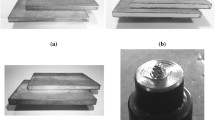Abstract
Welding and joining of magnesium alloys exert a profound effect on magnesium application expansion, especially in ground and air transportations where large-size, complex components are required. Due to specific physical properties of magnesium, its welding requires great control. In general, the solid-state nature of friction stir welding (FSW) process has been found to produce a low concentration of defects. In the current research, specimens from AZ31 magnesium alloy were welded together using the friction stir process with previously inserted SiC powder particles in the nugget zone. In other words, during the FSW process, the pre-placed SiC particles were stirred throughout the nugget zone of the weld. The results indicated that proper values of rotation and translation speeds led to good appearance of weld zone and suitable distribution of SiC particles producing increased weld strength. The comparison of the microstructures and mechanical properties of FS-welded AZ31 with those of FS-welded one using pre-placed SiC particles showed that the addition of SiC particles decreased the grain size and increased the strength and the formability index.











Similar content being viewed by others
References
H.E. Friedrich and B.L. Mordike, Magnesium Technology: Metallurgy, Design Data, Applications, Springer, Berlin, 2006
Y. Morisada, H. Fujii, T. Nagaoka, and M. Fuukusumi, Effect of Friction Stir Processing with SiC Particles on Microstructure and Hardness of AZ31, Mater. Sci. Eng. A, 2006, 433, p 50–54
W.B. Lee, J.W. Kim, Y.M. Yeon, and S.B. Jung, The Joint Characteristics of Friction Stir Welding AZ91D Magnesium Alloy, Mater. Trans., 2003, 44, p 917–923
F. Czerwinski, Magnesium Alloys: Design, Processing and Properties, InTech Publishing, Croatia, 2011
P. Kurtyka, I. Sulima, W. Wojcicka, N. Rylko, and A. Pietras, The Influence of Friction Stir Welding Process on Structure and Mechanical Properties of the AlSiCu/SiC Composites, J. Achiev. Mater. Manuf. Eng., 2012, 55, p 339–344
P.V. Kumar, G.M. Reddy, and K.S. Rao, Microstructure and Pitting Corrosion of Armor Grade AA7075 Aluminum Alloy Friction Stir Weld Nugget Zone-Effect of Post Weld Heat Treatment and Addition of Boron Carbide, Def. Technol., 2015. doi:10.1016/j.dt.2015.01.002
Y. Huang, T. Wang, W. Guo, L. Wan, and S. Lv, Microstructure and Surface Mechanical Property of AZ31/SiC Surface Composite Fabricated by Direct Friction Stir Processing, Mater. Des., 2014, 59, p 274–278
H. Zhang, S.B. Lin, L. Wu, and J.C. Feng, Microstructural Studies of Friction Stir Welded AZ31 Magnesium Alloy, Acta Metall. Sin., 2004, 17, p 747–753
P. Karthikeyan and K. Mahadevan, Investigating on the Effects of SiC Particles Addition in the Weld Zone During Friction Stir Welding of Al 6351 Alloy, Int. J. Adv. Manuf. Technol., 2015. doi:10.1007/s00170-015-7160-9
Y.F. Sun and H. Fujii, The Effect of SiC Particles on the Microstructure and Mechanical Properties of Friction Stir Welded Pure Copper Joints, Mater. Sci. Eng. A, 2011, 528, p 5470–5475
ASTM E112–13, Standard Test Methods for Determining Average Grain Size, ASTM International, West Conshohocken, 2013
ASTM E8, E8 M-15, Standard Test Methods for Tension Testing of Metallic Materials, ASTM International, West Conshohocken, 2015
ASTM E384–11e1, Standard Test Method for Knoop and Vickers Hardness of Materials, ASTM International, West Conshohocken, 2011
D. Hull and D.J. Bacon, Introduction to Dislocations, 5th ed., Elsevier, New York, 2011
M. Abbasi, B. Bagheri, and R. Keivani, Thermal Analysis of Friction Stir Welding Process and Investigation into Affective Parameters Using Simulation, J. Mech. Sci. Technol., 2015, 29, p 861–866
G.E. Dieter and D. Bacon, Mechanical Metallurgy, McGraw-Hill, London, 1988
T. Mukai, T. Mohri, M. Mabuchi, M. Nakamura, K. Ishikawa, and K. Higashi, Experimental Study of a Structural Magnesium Alloy with High Absorption Energy Under Dynamic Loading, Scripta Mater., 1998, 39, p 1249–1253
Y.Z. Estrin, P.A. Zabrodin, I.S. Braude, T.V. Grigorova, N.V. Iasev, V.V. Pustovalov, V.S. Fomenko, and S.E. Shumilin, Low-Temperature Plastic Deformation of AZ31 Magnesium Alloy with Different Microstructures, Low Temp. Phys., 2010, 36, p 1100–1106
R.S. Mishra, P.S. De, and N. Kumar, Friction Stir Welding and Processing: Science and Engineering, Springer, London, 2014
M. Dadaei, H. Omidvar, B. Bagheri, M. Jahazi, and M. Abbasi, The Effect of SiC/Al2O3 Particles Used During FSP on Mechanical Properties of AZ91 Magnesium Alloy, Int. J. Mater. Res., 2014, 105, p 369–374
J. Guo, B.Y. Lee, C.N. Sun, G. Bi, and J. Wei, Effect of Nano-particle Addition on Grain Structure Evolution of Friction Stir Processed Al 60 61 During Post-Weld Annealing, 2015 TMS Annual Meeting & Exhibition, Orlando, USA
M. Naderi, M. Abbasi, and A. Saeed-Akbari, Enhanced Mechanical Properties of a Hot-Stamped Advanced High-Strength Steel Via Tempering Treatment, Met. Mater. Trans. A, 2014, 44, p 1852–1861
Author information
Authors and Affiliations
Corresponding author
Rights and permissions
About this article
Cite this article
Abbasi, M., Abdollahzadeh, A., Bagheri, B. et al. The Effect of SiC Particle Addition During FSW on Microstructure and Mechanical Properties of AZ31 Magnesium Alloy. J. of Materi Eng and Perform 24, 5037–5045 (2015). https://doi.org/10.1007/s11665-015-1786-5
Received:
Revised:
Published:
Issue Date:
DOI: https://doi.org/10.1007/s11665-015-1786-5




